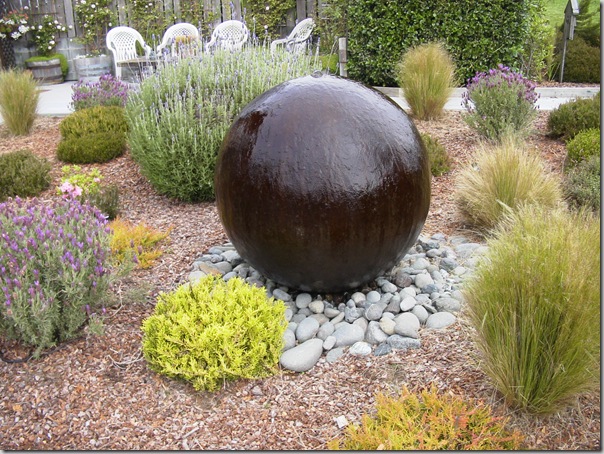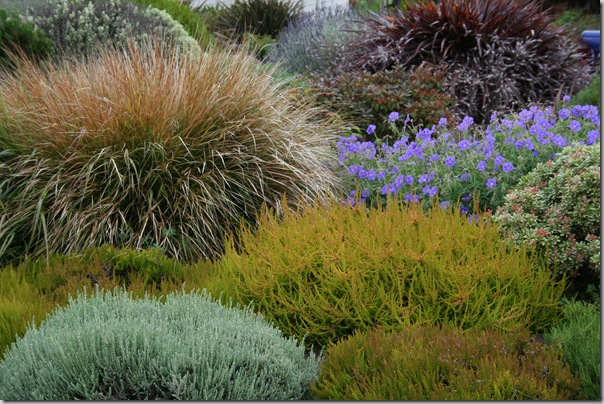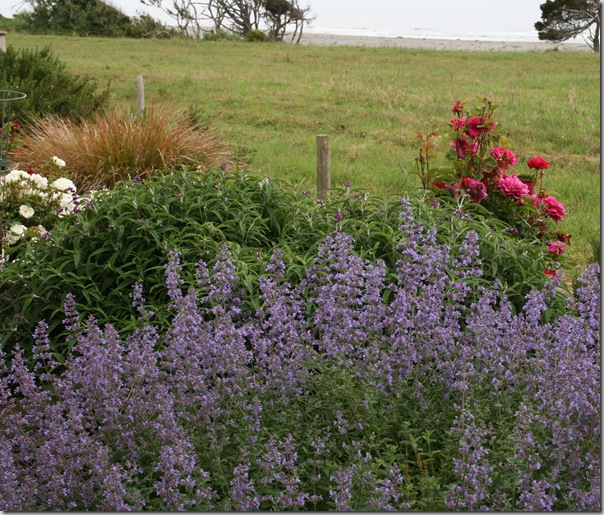
Coastal gardening presents some big challenges. There is constant strong wind, sandy soil that doesn’t hold water well and is lean on nutrients, and the salt! Oh, the salt.
Of course, it has its benefits too. Nowhere else do you get such a sense of motion in the landscape, between the beauty of the waves and movement of the foliage in the wind.
And if you can incorporate the ocean view into your garden design, working with your layout and plantings to make the view feel like it’s part of your garden rather than a far-off bit of scenery – then your landscaped areas can take on a sense of openness and grandeur that other gardens can’t touch.
Over the course of the month, in between other posts, I’m going to be talking about some of the plants that thrive in windy seacoast conditions, design tips to make the most of your space, and books that you’ll find helpful if you’re gardening on the coast.
To start, I want to talk about a few coastal gardening tips that might go counter to what you’ve learned about gardening elsewhere.
Design with mostly lower-growing plants
While in a regular garden it’s great to have varying heights for visual balance, in a coastal garden tree canopies and large shrubs tend to act as sails, which catch the wind and whip the poor plant around. I’ve seen 3” diameter tree trunks simply snap on a very windy day.
Obviously there are some places where you’ll want to create privacy or screening, or where you’ll need the visual weight of a tree or tall shrub. But on the whole, the taller the plant, the more grief you’ll have getting it established and keeping it healthy. Work with your surroundings, and when in doubt select a lower-growing plant.
Plant in masses
On a similar note, planting masses of the same plant and allowing them to grow together in a happy grouping has two benefits. First, plants that are the same height tend to get less wind and salt burn because the wind just goes up and over the whole group. The wind seems to catch more on plantings of various heights, which means each plant tends to sustain more damage in highly mixed plantings.
The second reason is that plants growing together in a mass creates a visual echo of the ocean waves. That creates the subconscious sense that your garden fits with the surroundings. Obviously, you’ll want to allow enough room for each plant to spread to mature size when you plant. Whenever possible, plan for their edges to just touch when they are mature. The constant airflow in a coastal garden helps prevent the fungal disease that can happen in normal gardens if plants are massed closely.
Buy bigger plants to start
While in most gardens, a one-gallon size pot is perfectly sufficient to make sure your plant will survive the shock of transplant, in really tough conditions, it can be better to start with plants in larger pots, particularly for woody shrubs. Because the wind is constantly causing them to lose moisture, the larger the pot, the more root mass and foliage your plants will have to help them replace lost moisture and nutrients.
Just stake any plants that are in danger of blowing over (be sure to allow them to sway with the wind to encourage their trunks to develop “muscle”!), and select plants that look hardened-off – don’t pick the lushest, fluffiest plants at the nursery, that have been over-fertilized and babied.
Use overhead watering periodically
While most shrubs and perennials don’t appreciate their foliage being sprayed down regularly (I recommend drip irrigation for that reason), plants living in salty conditions actually benefit from being washed periodically. If you’re on the front lines where your plants are constantly buffeted by salty wind, then washing your plants and thoroughly wetting your soil once a month can help prevent foliage burning from salt, and can rinse salt buildup from the soil.
This is the only time when I’d even consider using sprinkler heads or overhead watering for landscape plants, because usually plants develop fungal diseases or just fail to thrive when their foliage is constantly wet. But right on the ocean, the water left on the foliage dries up very quickly, and the health benefits of rinsing the salt off the leaves seems to outweigh the threat of fungus that comes from irrigating with sprinklers.
Lastly, treat your plants with extra care
You may have heard that you can plant things in fall, let them get established through winter, and then not water during the growing season. That works for some plants, in some gardens. That will probably not work for your garden – sorry to be the bearer of bad news, here! Coastal gardens put their plants through waaaay too much stress and moisture loss to expect them to look great without care.
When starting new planting beds, amend the top 10” of the soil with plenty of compost and manure to help the sandy soil hold moisture and nutrients. Use a thick layer of wood chip mulch after planting to hold moisture in. Make sure you are watering regularly enough, and get out there and check the soil around your plants to be sure they are getting good coverage. Water is critical to success in a windy coastal garden.
Use organic fertilizers in your garden beds that will release slowly. Synthetic fertilizers like Miracle-Gro will wash straight through your sandy soil, providing a quick jolt of too much fertilizer, then stressing your plants through not enough. Organics tend to release at a more steady rate.
If you’re gardening on the coast, I hope you found these tips helpful!
Want to read more? Check out these articles:
Screens and Hedges to Block Wind on the Sea Coast


12 responses to “Coastal Gardening: How to Garden on the Seacoast”
Hi Gen,
I’m looking forward to following along with this series since I’ve picked up some great tips already. One thing I’ve never been clear on with coastal plantings is how far away from the actual shore line do you need to be concerned about coastal conditions like high wind and salt spray? It is just within sight of the water (the front lines as you refered to in your post) or are those conditions a concern for gardeners who live a few blocks away from the ocean too?
I would guess most herbs would do well, esp. rosemary, but I have no idea. I suspect you must also some some native plants that can handle the conditions?
Debbie, I’m making this series good for folks on the front lines of coastal spray, but it’s hard to say how far inland people have to worry about salt. Books say for miles, but that hasn’t really been my experience.
It seems to me that within about ten-twenty city blocks (1-2 miles?) there is still the driving wind – salt burn seems to be mostly within a few blocks of the ocean, in terms of having to make special accommodations in planting for it. It seems like if it’s well-blocked by the land or lots of trees then it isn’t so bad, but if the streets are very open with few trees, then the salty wind whips through the streets and hits the gardens.
Monica, yes, herbs do very well! Good guess!! There are definitely some native plants that can handle the conditions, too. I’ll get to those soon.
Glad you’re back, Gen! I checked in last week and got some scary error message.
Great post!
Thanks, Erin! Yes, I hope the scary error message is gone for good. What a nightmare that was! My tech geeks assure me it would not have harmed anyone reading normal things on my blog – it was a strange back-end thing that was linking out to some weird/ harmful stuff. Should be solved now, thank goodness. Thanks for checking back in!
[…] because they’re low-maintenance, deer-resistant, most are winter-hardy, they’ll take wind and seacoast wind with no problem, they look great in containers, can tolerate low-water conditions in the ground […]
[…] Recently I discussed some of the challenges people face when gardening in windy coastal conditions, and some counter-intuitive tips for gardening on the sea coast. […]
Genevieve,
Great post. Thank you for the great tips.
I look forward to the future series about coastal gardening.
[…] you’re gardening on the sea coast, the wind can make it hard to enjoy being outdoors. Using fast-growing hedges or screening plants […]
[…] Tips for Gardening on the Seacoast […]
[…] Tips on Gardening in Coastal Conditions […]
Hi
Its Jane here.I am a fanatical plant collector and have had many large gardens and collections of plants.I the last couple of years the garden is now on the coast but certainly not close to the actual beach.
Your article is the first I have read which mentions plants that I would like to be able to grow rather than just the usual “coastal plants”
I have altered the composition of the soil to an extent with some success but also with lots of failures.My latest is Cotinus Coggyria which I understood to be pretty tough.
Would you consider providing suggestions please for plants you have had success with for sun or shade .I am concerned at the no of plants which thrive and then drop dead.Surely adding compost does more than just give them a superficial start?
Jane